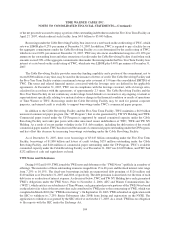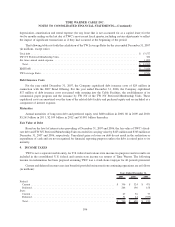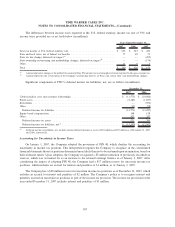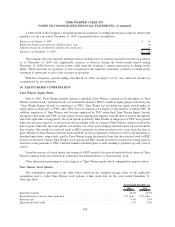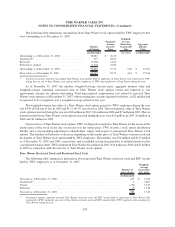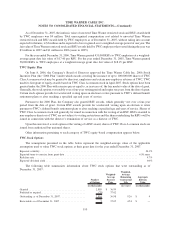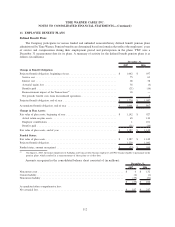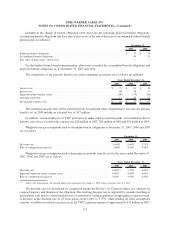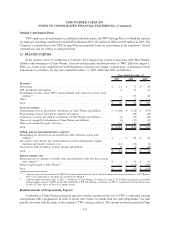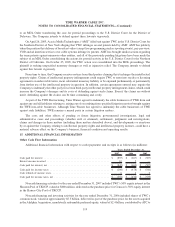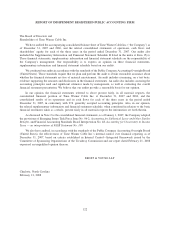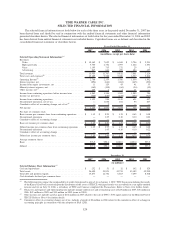Time Warner Cable 2007 Annual Report Download - page 119
Download and view the complete annual report
Please find page 119 of the 2007 Time Warner Cable annual report below. You can navigate through the pages in the report by either clicking on the pages listed below, or by using the keyword search tool below to find specific information within the annual report.In developing the expected long-term rate of return on assets, the Company considered the pension portfolio’s
composition, past average rate of earnings and discussions with portfolio managers. The expected long-term rate of
return is based on an asset allocation assumption of 75% equity securities and 25% fixed-income securities, which
approximated the actual allocation as of December 31, 2007. A decrease in the expected long-term rate of return of
25 basis points, from 8.00% to 7.75%, while holding all other assumptions constant, would have resulted in an
increase in the Company’s pension expense of approximately $3 million in 2007.
As of December 31, 2006, the Company converted to the RP-2000 Mortality Table for calculating the year-end
2007 and year-end 2006 pension obligations and 2007 expense. The impact of this change increased consolidated
pension expense for 2007 by $9 million. Additional demographic assumptions such as retirement and turnover rates
were also updated to reflect recent plan experience, which increased consolidated pension expense for 2007 by
$8 million.
The pension assets are held in a master trust with plan assets of another Time Warner defined benefit pension
plan (the “Master Trust”). The Master Trust’s assets include 4.4 million shares of Time Warner common stock in the
amount of $73 million (2% of total plan assets held in the Master Trust) as of December 31, 2007 and 4.4 million
shares in the amount of $97 million (3% of total plan assets held in the Master Trust) as of December 31, 2006. The
Master Trust’s weighted-average asset allocations by asset category are as follows: 79% equity securities and 21%
fixed-income securities as of December 31, 2007 and 77% equity securities and 23% fixed-income securities as of
December 31, 2006.
The Company’s investment policy for its pension plans is to maximize the long-term rate of return on plan
assets within an acceptable level of risk while maintaining adequate funding levels. The Company’s current broad
strategic targets are to have a pension assets portfolio comprising 75% equity securities and 25% fixed-income
securities, both within a target range of +/- five percentage points. Within equity securities, the Company’s objective
is to achieve asset diversity in order to increase return and reduce volatility. The Company has asset allocation
policy target ranges for growth and value U.S. equity securities; large, mid, and small capitalization U.S. equity
securities; international equity securities; and alternative investments. The Company’s fixed-income securities are
investment grade in aggregate. A portion of the fixed-income allocation is reserved in short-term cash investments
to provide for expected pension benefits to be paid in the short term.
The Company continuously monitors the performance of the overall pension assets portfolio, asset allocation
policies, and the performance of individual pension assets managers and makes adjustments and changes, as
required. Every five years, or more frequently if appropriate, the Company conducts a broad strategic review of its
portfolio construction and asset-allocation policies. The Company does not manage any assets internally, does not
have any passive investments in index funds, and does not utilize futures, options, or other derivative instruments or
hedging with regards to the pension plan (although the investment mandate of some pension asset managers allows
limited use of derivatives as components of their standard portfolio management strategies).
After considering the funded status of the Company’s defined benefit pension plans, movements in the
discount rate, investment performance and related tax consequences, the Company may choose to make
contributions to its pension plans in any given year. As of December 31, 2007, there were no minimum
required contributions for TWC’s funded plans. The Company expects to make discretionary cash
contributions of approximately $150 million to its funded plans during 2008, subject to market conditions and
other considerations. For the Company’s unfunded plan, contributions will continue to be made to the extent
benefits are paid. Benefit payments for the unfunded plan are expected to be $2 million in 2008.
Benefit payments for the Company’s defined benefit pension plans related to continuing operations, including
the unfunded plan previously discussed, are expected to be $19 million in 2008, $22 million in 2009, $25 million in
2010, $29 million in 2011, $34 million in 2012 and $267 million in 2013 to 2017.
114
TIME WARNER CABLE INC.
NOTES TO CONSOLIDATED FINANCIAL STATEMENTS—(Continued)


